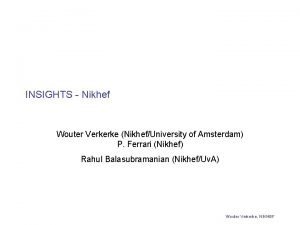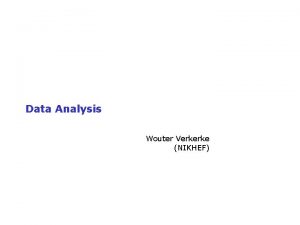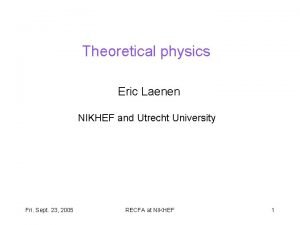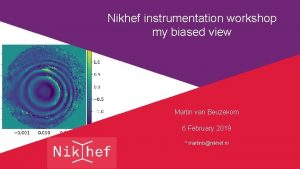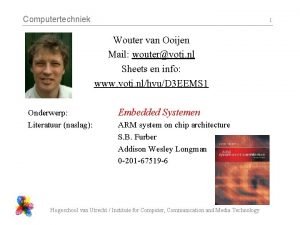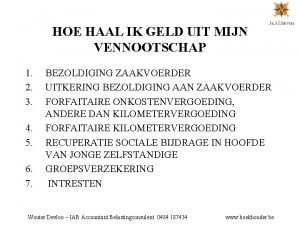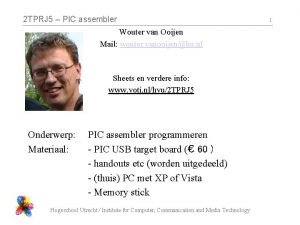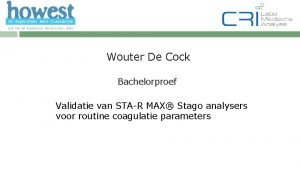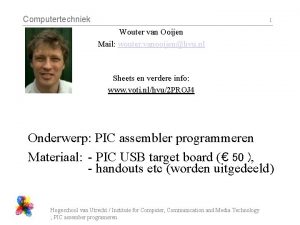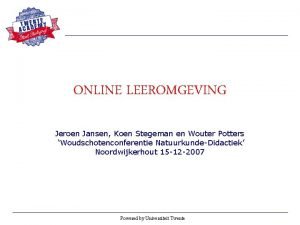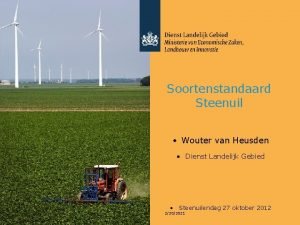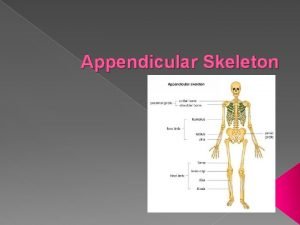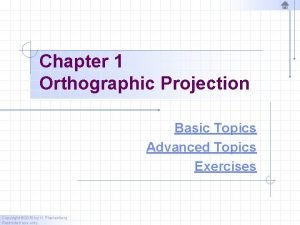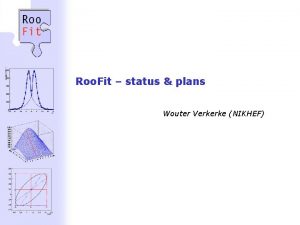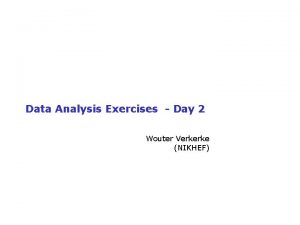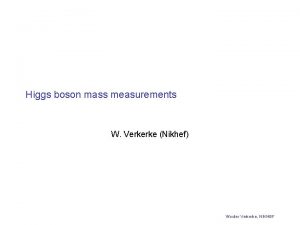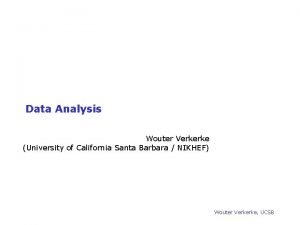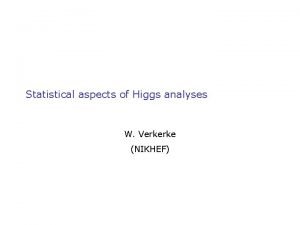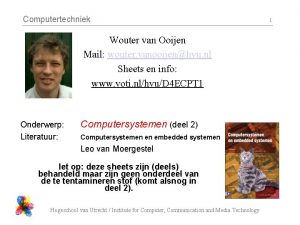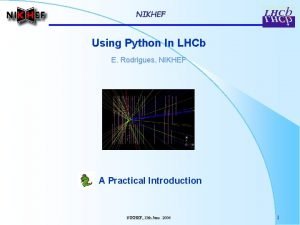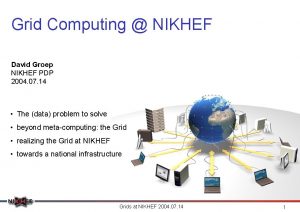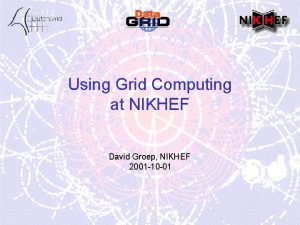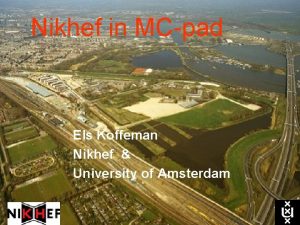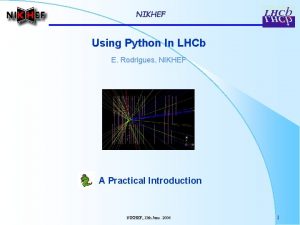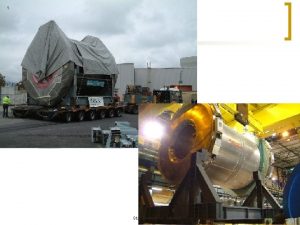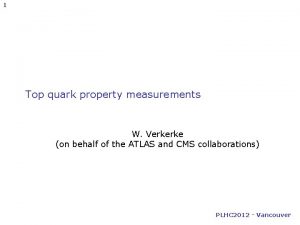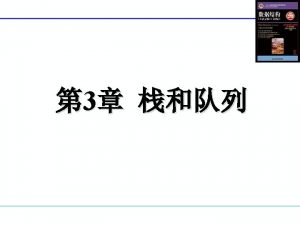Top paper status W Verkerke NIKHEF Wouter Verkerke





























- Slides: 29

Top paper status W. Verkerke (NIKHEF) Wouter Verkerke, NIKHEF

Introduction • Goal of top paper – observation of ttbar production and measurement of its cross section • Physics of SM top quark pair production, s=165 pb Dominant at Tevatron Dominant at LHC • Virtually all top quarks decay to t Wb • Thus final states classified by W decay modes: W qq (2/3) or W ln (1/3) – Dilepton channel (2 x. W ln), 1/9 of cross section – Lepton+jets channel (1 x. W ln), 4/9 of cross section – All Hadronic channel(0 x. W ln), 4/9 of cross section Wouter Verkerke, NIKHEF

Analysis strategy • Lepton+jets Look for events with 4 jets, of which 2 are b-jets, hard lepton, missing ET – Can reconstruct also invariant mass of jets from t W(qq)b, but simple procedures suitable for early data taking have low efficiency (~20 -30%) Not primary tool for early data analysis – Strategy: Evidence for top based on excess of events w. r. t known backgrounds • Dilepton Look for events with 2 jets, (of which 2 bjets) two hard leptons, missing ET – No easy clean signature in events that is characteristic for top – Strategy: Evidence for top based on excess of events w. r. t known backgrounds • Understanding of backgrounds is key – Use data driven approach wherever possible

General status of analysis • Lepton+jets – We think analysis procedures now all sorted out. – Ironing out last details, some discussion still ongoing on a few systematic uncertainties – Still need to update to final b-tagging efficiency uncertainties – Once procedures are finalized still need few days to (re)propagate latest changes in background estimations etc to cross section results • Dileptons – Analysis essentially complete – Still need some time to calculate final cross sections and combined cross section • All plots and numbers shown in this presentation are still subject to change Wouter Verkerke, NIKHEF

Data sample • All data taken in DQ periods A-F that pass ‘top’ GRL – Total luminosity = 2. 9 pb-1 • Triggers used (some time evolution) – L 1_ MU 10 or EF_mu 10_MSonly – L 1_EM 10, EF_g 17_etcut or EF_e 10_medium • Object definitions for events selection – Electron = ‘medium robust electron’ with p. T>20, E/p and b-layer cuts |ηcluster|<2. 47 (excluding 1. 37<h<1. 52), isolation: ET(R=0. 2)< 4 + 0. 023*ET(el) Ge. V – Muon = ‘MUID tight’, p. T>20 Ge. V, |h|<2. 5 ET(R=0. 3)<4 Ge. V, PT(R=0. 3)<4 Ge. V DR>0. 4 w. r. t nearest jet with p. T>20 Ge. V – Jet = Anti. Kt 4 Topo. Cluster jets EM+JES. DR(jet-el)>0. 2. – B-jet = Jet + SV 0 cut at 50% MC efficiency point – Missing ET = Simplified METRef. Final Details in https: //twiki. cern. ch/twiki/bin/view/Atlas. Protected/Top. Common. Objects Wouter Verkerke, NIKHEF

Event selection for lepton+jets channel • Event samples named 1, 2, 3, 4 -jet pretag defined as – The appropriate single electron or muon trigger has fired – Exactly one lepton (el or mu) with p. T>20, matching the corresponding trigger object – ETmiss>20 Ge. V and ETmiss+m. T(W)>60 Ge. V – Exactly N jets with p. T>25 Ge. V (N=1, 2, 3) or >=4 jets (N=4) Wouter Verkerke, NIKHEF

Event selection for lepton+jets channel • Corresponding samples after b-tagging: 1, 2, 3, 4 -jet tagged signal region – Added requirement = 1 b-tagged jet with p. T>25 20 evts 17 evts ttbar events Wouter Verkerke, NIKHEF

Background in the lepton+jets analysis • QCD multijet events – Contributions with non-prompt leptons (semileptonic decays resulting in hard non-prompt leptons) – Contributions with fake leptons (in e+jets channel) – Large (and uncertain) cross section, small (and uncertain) acceptance rate simulation is not reliable – Developed fully data driven estimate of this background • W+jets events – Sizeable contributions from each of W+light jets, W+bb+jets, W+cc+jets, W+c+jets – Partly irreducible (W+bb+jets has same final state as signal) – W+4 jets cross section has large uncertainty. HF composition of this sample has additional substantial theoretical uncertainty. – Developed nearly fully data driven estimate • single top, Z+jets, dibosons – Small background, can use MC estimates, large cross section error (Z+jets) has small impact Wouter Verkerke, NIKHEF

Data driven estimate of QCD background • Use matrix method to estimate # QCD events with fake leptons in m+jets channel – Measure event count with loose and tight(=standard) lepton ID cuts – Can related Nloose, Ntight to Ntight(fake) if you know relative ereal, efake – Can measure ereal from Z(mm) events = 0. 990 ± 0. 003 – Can measure efake from QCD dominated control region • QCD control regions – A: ETmiss < 10 Ge. V efake = 0. 382 ± 0. 007 (stat only) – B: d 0 -sig(m)>5 && ETmiss>20 efake 0. 295 ± 0. 025 (stat only) – Key: Is control region (kinematically) representative of signal region? – Check 1 – Test on QCD MC sample 30% systematic – Check 2 – Compare control regions (no MC dependence) use difference as metric of systematic uncertainty – Total systematic uncertainty is combination of both Wouter Verkerke, NIKHEF

Data driven estimate of QCD background • Can test-drive method on 1 -jet samples 1 -jet pretag sample without MT(w) cut 1 -jet tagged sample without MT(w) cut Data W+jets simulation QCD (data driven – matrix method) Wouter Verkerke, NIKHEF

Data driven estimate of QCD background • Estimate QCD with MM in pretag samples – Statistics too low after flavor tagging – Instead estimate contribution in tagged samples by multiplying pretag numbers with measured tag rates • Use fitting method to estimate #QCD events with fake leptons in e+jets events – Matrix Method less reliable for e+jets due to sizeable contribution from both HF and non-HF sources which introduces additional issues in representativeness of control samples – Not described here due to time constraints. • Results in 4 -jet tagged samples – e+jets: N(QCD) = 4. 9 ± 2. 9 – m+jets: N(QCD) = 1. 7 ± 1. 1 – Numbers include systematic uncertainties Wouter Verkerke, NIKHEF

Estimation of W+jets background • Start with estimation in 4 -jet pretag bin – Exploit approximate constant ratio of W+N+1 jets/W+Njets cross sections to extrapolate W+1, 2 jets to W+4 jets – ‘Berends-Giele’ scaling. Systematic uncertainties related to this idea relatively well explored in existing publications (24%) – Measure W+1, 2 jets by subtracting data driven QCD estimate from 1, 2 -jet pretag bins (+ MC estimates for other processes) • Estimate in 4 -jet tagged samples with – Measure 2 -jet tag fraction from data (subtracting QCD and other bkg) – Account for evolution of HF composition between 2 -jet and 4 -jet bin with MC factor Wouter Verkerke, NIKHEF

Estimation of W+jets background • Results e+jets: 11. 4± 2. 2(stat. )± 4. 8(syst. ) mu+jets: 19. 8± 4. 2(stat. )± 5. 4(syst. ) ( 6. 3± 1. 8(stat. )± 0. 2(syst. ) )% 2. 4 ± 0. 8 (syst. ) • Note on MC input uncertainties on f(2 4) – HF composition of 2 -jet sample: 300% relative uncertainty on f(bb), f(cc), 100% on f(c) – Per-component tag fractions: uncertainties from tagging group – 2 4 jet extrapolation ratios: 2 x magnitude of effect of Alpgen param. variation studies (40 -60% per component) W(eν)tagged-≥ 4 jet = 1. 6± 1. 0 (63%) W(μν)tagged-≥ 4 jet = 3. 0± 1. 7 (58%) Wouter Verkerke, NIKHEF

Lepton+jets event yield • Calculate ttbar event yield – subtract all background estimates from data yield in 4 -jet tagged sample • e+jets: Nobs = 17 N(ttbar) = 9. 9 ± 3. 1 • m+jets: Nobs = 20 N(ttbar) = 15. 6 ± 1. 8 Wouter Verkerke, NIKHEF

Lepton + jets cross section • Calculate cross section using MC acceptance – e+jets: e(MC@NLO) = 0. 0282 ± 24% – m+jets: e(MC@NLO) = 0. 0285 ± 24% 29% 28% stat, syst ~40% each σ(e+j) = 122 ± 51(stat) +59 -47(syst) pb σ(m+j) = 189 ± 54(stat) +69 -47(syst) pb stat, syst ~30% each [ s(theory)=165 pb ] – Combined cross section calculation in progress Need careful propagation of correlated systematic errors. – Have tool to do this – was developed from dilepton cross section combination in 2009 Summer PUB notes. Expect numbers by end of this week NUMBERS NOT FINAL – CHANGES STILL EXPECTED Wouter Verkerke, NIKHEF

Lepton+jets systematic uncertainties • Systematic uncertainties on cross section by component – b/c. Tag uncertainty based on preliminary 24%/48% flavor tagging uncertainty This number can still change – Jet Energy Scale ~10% at 25 Ge. V

Alternative calculation of e/m+jets cross section • A Counting method based on 1, 2, 4 jet bins • B Can also extract yield from 3, 4 jet bins – But more complex as 3 -jet bin has substantial ttbar contribution • C Can also exploit information of 4 -jet untagged sample – With supporting information from 3 -jet tagged, untagged bins as well • Solutions B, C implemented as template fits to m(jjj) distribution – Shape information gives some discrimination power between signal and background – Introduce known correlations between signal and background in various bins Wouter Verkerke, NIKHEF

Alternative calculation lepton+jets cross section • Results from B (3+4 jet tagged samples) s(e+jets) = 102. 1 pb s(m+jets)= 186. 2 pb +42. 2/ +13. 6/ -59. 1 (stat) -30. 9(syst) -9. 6 (lumi) +78. 4/ +73. 7/ +23. 6/ -69. 6 (stat) -33. 0(syst) -16. (lumi) +67. 2 • Results from C (4 jet tagged/untagged) Verkerke, NIKHEF NUMBERS NOT FINAL – CHANGES STILLWouter EXPECTED

Summary on lepton+jets • Observe clear excess of events in 3, 4 -jet tagged samples consistent with ttbar • Have fully data driven estimate of QCD background • Have almost fully data driven estimate of W+jets background • Can extract ttbar yield/ cross section using different combination of control regions – Counting (1, 2, 4), Fitting (3, 4) Fitting (4, 4 -untag) • Cross section results consistent with SM prediction • Signal significance in l+jets likely just short of 5 sigma Wouter Verkerke, NIKHEF

Event selection for the dilepton channel • Three channels: ee, mm, em • Event selection – Two opposite sign leptons (one must match trigger object) – Cosmic veto – |d 0|>0. 5 mm , df>3. 1 – ETmiss>40 Ge. V (ee), ETmiss>30 Ge. V (mm), HT>150 Ge. V (em) – Z mass veto (± 5 Ge. V ee, ± 10 Ge. V mm) – At least 2 jets with p. T>20 Ge. V (signal region) ee mm em Wouter Verkerke, NIKHEF

Event selection for the dilepton channel ee mm em Wouter Verkerke, NIKHEF

Backgrounds in the dilepton analysis • W+jets – W+ 2 jets events with additional fake lepton pass event selection – Relatively large cross section, MC fake rate not reliable – Data driven estimation (procedure includes other smaller backgrounds with two fake leptons) • Z+jets (Drell-Yan) – Most Z+jets events rejected with Z mass veto on lepton invariant mass, but some leakage – Insufficient data available for fully data driven estimate, have partially data driven method • Single top, Dibosons, Z tt – Comparatively small contributions Use MC estimates Wouter Verkerke, NIKHEF

Data driven estimate of fake lepton bkg (W+jets) • Fake lepton background measured with Matrix Method. – Similar to lepton+jets, but now have 4 x 4 matrix due to 4 permutations of Loose, Tight for 2 leptons – Value of ereal measured again from Z ll events – Value of efake measured in control sample with single loose lepton • Additional ‘weighting’ and ‘fitting’ method as cross check Wouter Verkerke, NIKHEF

Data assisted estimate of Z+jets background • Schematic illustration Rescale A+C from MC with data/MC ratio in B+E N(ee) = 0. 25 ± 0. 18, N(mm) = 0. 67 ± 0. 38, N(em)=0 (full systematics included) Wouter Verkerke, NIKHEF

Dilepton event yield • Calculate ttbar event yield – subtract all background estimates from data yield • ee: Nobs = 2 N(ttbar) = 1. 31 ± 0. 37 • mm: Nobs = 3 N(ttbar) = 2. 10 ± 0. 41 • em: Nobs = 4 N(ttbar) = 2. 97 ± 0. 57 Wouter Verkerke, NIKHEF

Dilepton cross section • Calculate cross section using MC acceptance – ee: e(MC@NLO) = 0. 15 ± 0. 02 – mm: e(MC@NLO) = 0. 23 ± 0. 02 – em: e(MC@NLO) = 0. 25 ± 0. 02 σ(ee) = 175 ± 195(stat)± 69(syst) pb σ(mm) = 179 ± 150(syst) ± 53(syst) pb σ(em) = 118 ± 82(stat) ± 19(syst) pb – Combined cross section calculation in progress Need careful propagated of correlated systematic errors. – Have tool to do this – was developed from dilepton cross section combination in 2009 Summer PUB notes. Expect numbers by end of this week NUMBERS NOT FINAL – CHANGES STILL Wouter EXPECTED Verkerke, NIKHEF

Dilepton acceptance systematics • Systematic uncertainties on acceptance by component Wouter Verkerke, NIKHEF

Next steps • Await calculation of final numbers (days). Once that is done: • Schedule top-wg analysis approval meeting • Send paper draft to Ed Board Wouter Verkerke, NIKHEF

Documentation status • Paper draft (~22 pages) is reasonably good shape, mostly needs final numbers • Series of 11 internal notes in preparation since 4 months documenting all analysis aspects in detail – 1: Lepton selection and performance 2: Jet selection and performance 3: ETmiss performance 4: B-tagging performance 5: Fake lepton background 6: W+jets background 7: Drell-Yan background 8: Top. Inputs and D 2 PD software 9: MC samples 10: Lepton+jets analysis strategy 11: Dilepton analysis strategy – Expect updated versions of notes 1 -9 by the end of this week – Working on making updated notes 10, 11 available next week. Will include summary of essential results of Notes 1 -9 here to make these the primary supporting documents for collaboration circulation. (But all notes will go into CDS as COM notes) Wouter Verkerke, NIKHEF
 Langrangian
Langrangian Wouter verkerke
Wouter verkerke Vista 25
Vista 25 Servicdesk
Servicdesk Utrecht theoretical physics
Utrecht theoretical physics Nikhef
Nikhef Wouter van ooijen
Wouter van ooijen Wouter van der zwan
Wouter van der zwan Wouter arrazola de oñate
Wouter arrazola de oñate Wouter devloo
Wouter devloo Tprj
Tprj Wouter akema
Wouter akema Wouter hulsbergen
Wouter hulsbergen Dr deseyn
Dr deseyn Wouter bouwman relatie
Wouter bouwman relatie Validatieplan
Validatieplan Wouter bosmans
Wouter bosmans Wouter van ooijen
Wouter van ooijen Wouter hinssen
Wouter hinssen Wouter stegeman
Wouter stegeman Wouter dursin
Wouter dursin Wouter veiland
Wouter veiland Wouter van heusden
Wouter van heusden English general paper paper 2 comprehension
English general paper paper 2 comprehension Aice general paper hand approach
Aice general paper hand approach Acetebelum
Acetebelum Scientific management
Scientific management Auxiliary view drawing
Auxiliary view drawing Gimpose
Gimpose Top semiconductor ip companies
Top semiconductor ip companies
